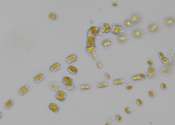Microphytes or microalgae are microscopic algae, typically found in freshwater and marine systems. They are unicellular species which exist individually, or in chains or groups. Depending on the species, their sizes can range from a few micrometers (µm) to a few hundreds of micrometers. Unlike higher plants, microalgae do not have roots, stems and leaves. Microalgae, capable of performing photosynthesis, are important for life on earth; they produce approximately half of the atmospheric oxygen and use simultaneously the greenhouse gas carbon dioxide to grow photoautotrophically.
The biodiversity of microalgae is enormous and they represent an almost untapped resource. It has been estimated that about 200,000-800,000 species exist of which about 35,000 species are described. Over 15,000 novel compounds originating from algal biomass have been chemically determined (Cardozo et al. 2007). Most of these microalgae species produce unique products like carotenoids, antioxidants, fatty acids, enzymes, polymers, peptides, toxins and sterols.









